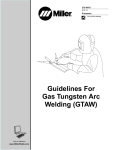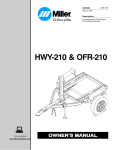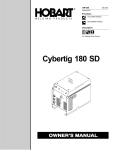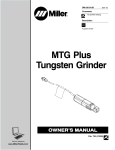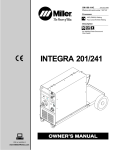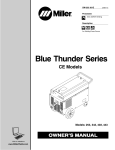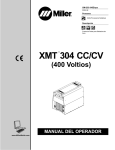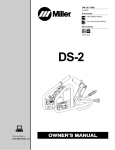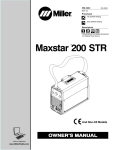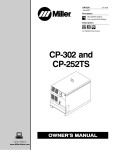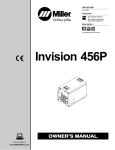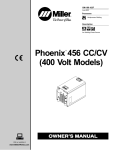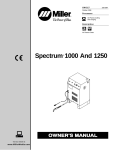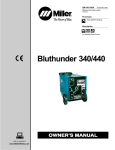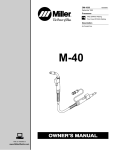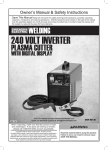Download Miller Gold Seal 160 i Owner`s manual
Transcript
OM-189 116A June 1999 Effective with Serial N° 230 Volt – 159 262 240 Volt – 160 261 Processes TIG (GTAW) Welding Stick (SMAW) Welding Description Arc Welding Power Source Gold Seal 160 i Visit our website at www.MillerWelds.com From Miller to You Thank you and congratulations on choosing Miller. Now you can get the job done and get it done right. We know you don’t have time to do it any other way. That’s why when Niels Miller first started building arc welders in 1929, he made sure his products offered long-lasting value and superior quality. Like you, his customers couldn’t afford anything less. Miller products had to be more than the best they could be. They had to be the best you could buy. Today, the people that build and sell Miller products continue the tradition. They’re just as committed to providing equipment and service that meets the high standards of quality and value established in 1929. This Owner’s Manual is designed to help you get the most out of your Miller products. Please take time to read the Safety precautions. They will help you protect yourself against potential hazards on the worksite. We’ve made installation and operation quick and easy. With Miller you can count on years of reliable service with proper maintenance. And if for some reason the unit needs repair, there’s a Troubleshooting section that will help you figure out what the problem is. The parts list will then help you to decide which exact part you may need to fix the problem. Warranty and service information for your particular model are also provided. Working as hard as you do – every power source from Miller is backed by the most hassle-free warranty in the business. Miller Electric manufactures a full line of welders and welding related equipment. For information on other quality Miller products, contact your local Miller distributor to receive the latest full line catalog or individual catalog sheets. TABLE OF CONTENTS The following terms are used interchangeably throughout this manual: TIG = GTAW Stick = SMAW SECTION 1 – SAFETY PRECAUTIONS - READ BEFORE USING . . . . . . . . . 1-1. Symbol Usage . . . . . . . . . . . . . . . . . . . . . . . . . . . . . . . . . . . . . . . . . . . . . . . . . 1-2. Arc Welding Hazards . . . . . . . . . . . . . . . . . . . . . . . . . . . . . . . . . . . . . . . . . . . 1-3. Additional Symbols for Installation, Operation, and Maintenance . . . . . . 1-4. Principal Safety Standards . . . . . . . . . . . . . . . . . . . . . . . . . . . . . . . . . . . . . . 1-5. EMF Information . . . . . . . . . . . . . . . . . . . . . . . . . . . . . . . . . . . . . . . . . . . . . . . SECTION 2 – INSTALLATION . . . . . . . . . . . . . . . . . . . . . . . . . . . . . . . . . . . . . . . . . 2-1. Specifications . . . . . . . . . . . . . . . . . . . . . . . . . . . . . . . . . . . . . . . . . . . . . . . . . 2-2. Duty Cycle And Overheating . . . . . . . . . . . . . . . . . . . . . . . . . . . . . . . . . . . . 2-3. Volt-Ampere Curve . . . . . . . . . . . . . . . . . . . . . . . . . . . . . . . . . . . . . . . . . . . . . 2-4. Selecting A Location . . . . . . . . . . . . . . . . . . . . . . . . . . . . . . . . . . . . . . . . . . . 2-5. Typical Connections . . . . . . . . . . . . . . . . . . . . . . . . . . . . . . . . . . . . . . . . . . . . 2-6. Front Panel Connections . . . . . . . . . . . . . . . . . . . . . . . . . . . . . . . . . . . . . . . . 2-7. Weld Output Terminals And Selecting Cable Sizes . . . . . . . . . . . . . . . . . . 2-8. Electrical Service Guide . . . . . . . . . . . . . . . . . . . . . . . . . . . . . . . . . . . . . . . . 2-9. Connecting Input Power . . . . . . . . . . . . . . . . . . . . . . . . . . . . . . . . . . . . . . . . SECTION 3 – OPERATION . . . . . . . . . . . . . . . . . . . . . . . . . . . . . . . . . . . . . . . . . . . 3-1. Controls . . . . . . . . . . . . . . . . . . . . . . . . . . . . . . . . . . . . . . . . . . . . . . . . . . . . . . SECTION 4 – MAINTENANCE AND TROUBLESHOOTING . . . . . . . . . . . . . . . 4-1. Routine Maintenance . . . . . . . . . . . . . . . . . . . . . . . . . . . . . . . . . . . . . . . . . . . 4-2. Troubleshooting . . . . . . . . . . . . . . . . . . . . . . . . . . . . . . . . . . . . . . . . . . . . . . . SECTION 5 – ELECTRICAL DIAGRAMS . . . . . . . . . . . . . . . . . . . . . . . . . . . . . . . SECTION 6 – SELECTING AND PREPARING TUNGSTEN ELECTRODE . . 6-1. Selecting Tungsten Electrode . . . . . . . . . . . . . . . . . . . . . . . . . . . . . . . . . . . . 6-2. Safety Information About Tungsten . . . . . . . . . . . . . . . . . . . . . . . . . . . . . . . 6-3. Preparing Tungsten For DC Electrode Negative (DCEN) Welding . . . . . SECTION 7 – GUIDELINES FOR TIG WELDING (GTAW) . . . . . . . . . . . . . . . . 7-1. Positioning The Torch . . . . . . . . . . . . . . . . . . . . . . . . . . . . . . . . . . . . . . . . . . 7-2. Torch Movement During Welding . . . . . . . . . . . . . . . . . . . . . . . . . . . . . . . . . 7-3. Positioning Torch Tungsten For Various Weld Joints . . . . . . . . . . . . . . . . SECTION 8 – PARTS LIST . . . . . . . . . . . . . . . . . . . . . . . . . . . . . . . . . . . . . . . . . . . . WARRANTY 1 1 1 3 3 4 5 5 5 6 6 7 7 8 8 9 10 10 10 10 11 12 14 14 15 15 16 16 16 17 18 Declaration of Conformity Manufacturer’s Name: ITW WELDING PRODUCTS ITALY S.r.l. Manufacturer’s Address: Via Privata Iseo, 6/E 20098 San Giuliano Milanese, Italy Declares that this product: Gold SealR 160 i Conforms to the following Directives and Standards: Directives Electromagnetic Compatibility Directives: 89/336/EEC Low Voltage: 73/23/EEC Machinery Directives: 89/392/EEC And their amendments 91/368/EEC, 93/31/EEC, 93/44/EEC, 93/68/EEC Standards Electromagnetic compatibility (EMC) Product standard for arc welding equipment: EN50199: August 1995 Safety Requirements for Arc Welding Equipment Part 1: EN 60974-1: 1989 European Contact: Telephone: Fax: dec_con1_italy11/02 Mr. Danilo Fedolfi, Managing Director ITW WELDING PRODUCTS ITALY S.r.l. Via Privata Iseo, 6/E 20098 San Giuliano Milanese, Italy 39(02)98290-1 39(02)98290-203 SECTION 1 – SAFETY PRECAUTIONS - READ BEFORE USING som _nd_7/02 1-1. Symbol Usage Means Warning! Watch Out! There are possible hazards with this procedure! The possible hazards are shown in the adjoining symbols. Y Marks a special safety message. . Means “Note”; not safety related. This group of symbols means Warning! Watch Out! possible ELECTRIC SHOCK, MOVING PARTS, and HOT PARTS hazards. Consult symbols and related instructions below for necessary actions to avoid the hazards. 1-2. Arc Welding Hazards Y The symbols shown below are used throughout this manual to call attention to and identify possible hazards. When you see the symbol, watch out, and follow the related instructions to avoid the hazard. The safety information given below is only a summary of the more complete safety information found in the Safety Standards listed in Section 1-4. Read and follow all Safety Standards. D If earth grounding of the workpiece is required, ground it directly with a separate cable. Y Only qualified persons should install, operate, maintain, and repair this unit. D Wear a safety harness if working above floor level. D Keep all panels and covers securely in place. Y During operation, keep everybody, especially children, away. D Clamp work cable with good metal-to-metal contact to workpiece or worktable as near the weld as practical. ELECTRIC SHOCK can kill. Touching live electrical parts can cause fatal shocks or severe burns. The electrode and work circuit is electrically live whenever the output is on. The input power circuit and machine internal circuits are also live when power is on. In semiautomatic or automatic wire welding, the wire, wire reel, drive roll housing, and all metal parts touching the welding wire are electrically live. Incorrectly installed or improperly grounded equipment is a hazard. D Do not touch electrode if you are in contact with the work, ground, or another electrode from a different machine. D Use only well-maintained equipment. Repair or replace damaged parts at once. Maintain unit according to manual. D Insulate work clamp when not connected to workpiece to prevent contact with any metal object. D Do not connect more than one electrode or work cable to any single weld output terminal. SIGNIFICANT DC VOLTAGE exists after removal of input power on inverters. D Turn Off inverter, disconnect input power, and discharge input capacitors according to instructions in Maintenance Section before touching any parts. D Do not touch live electrical parts. D Wear dry, hole-free insulating gloves and body protection. D Insulate yourself from work and ground using dry insulating mats or covers big enough to prevent any physical contact with the work or ground. D Do not use AC output in damp areas, if movement is confined, or if there is a danger of falling. D Use AC output ONLY if required for the welding process. D If AC output is required, use remote output control if present on unit. D Disconnect input power or stop engine before installing or servicing this equipment. Lockout/tagout input power according to OSHA 29 CFR 1910.147 (see Safety Standards). D Properly install and ground this equipment according to its Owner’s Manual and national, state, and local codes. D Keep your head out of the fumes. Do not breathe the fumes. D Always verify the supply ground – check and be sure that input power cord ground wire is properly connected to ground terminal in disconnect box or that cord plug is connected to a properly grounded receptacle outlet. D When making input connections, attach proper grounding conductor first – double-check connections. D Frequently inspect input power cord for damage or bare wiring – replace cord immediately if damaged – bare wiring can kill. D Turn off all equipment when not in use. D Do not use worn, damaged, undersized, or poorly spliced cables. D Do not weld in locations near degreasing, cleaning, or spraying operations. The heat and rays of the arc can react with vapors to form highly toxic and irritating gases. D Do not drape cables over your body. FUMES AND GASES can be hazardous. Welding produces fumes and gases. Breathing these fumes and gases can be hazardous to your health. D If inside, ventilate the area and/or use exhaust at the arc to remove welding fumes and gases. D If ventilation is poor, use an approved air-supplied respirator. D Read the Material Safety Data Sheets (MSDSs) and the manufacturer’s instructions for metals, consumables, coatings, cleaners, and degreasers. D Work in a confined space only if it is well ventilated, or while wearing an air-supplied respirator. Always have a trained watchperson nearby. Welding fumes and gases can displace air and lower the oxygen level causing injury or death. Be sure the breathing air is safe. D Do not weld on coated metals, such as galvanized, lead, or cadmium plated steel, unless the coating is removed from the weld area, the area is well ventilated, and if necessary, while wearing an air-supplied respirator. The coatings and any metals containing these elements can give off toxic fumes if welded. OM-189 116 Page 1 ARC RAYS can burn eyes and skin. Arc rays from the welding process produce intense visible and invisible (ultraviolet and infrared) rays that can burn eyes and skin. Sparks fly off from the weld. D Wear a welding helmet fitted with a proper shade of filter to protect your face and eyes when welding or watching (see ANSI Z49.1 and Z87.1 listed in Safety Standards). D Wear approved safety glasses with side shields under your helmet. D Use protective screens or barriers to protect others from flash and glare; warn others not to watch the arc. D Wear protective clothing made from durable, flame-resistant material (leather and wool) and foot protection. BUILDUP OF GAS can injure or kill. D Shut off shielding gas supply when not in use. D Always ventilate confined spaces or use approved air-supplied respirator. HOT PARTS can cause severe burns. D Do not touch hot parts bare handed. D Allow cooling period before working on gun or torch. MAGNETIC FIELDS can affect pacemakers. WELDING can cause fire or explosion. Welding on closed containers, such as tanks, drums, or pipes, can cause them to blow up. Sparks can fly off from the welding arc. The flying sparks, hot workpiece, and hot equipment can cause fires and burns. Accidental contact of electrode to metal objects can cause sparks, explosion, overheating, or fire. Check and be sure the area is safe before doing any welding. D Protect yourself and others from flying sparks and hot metal. D Do not weld where flying sparks can strike flammable material. D Remove all flammables within 35 ft (10.7 m) of the welding arc. If this is not possible, tightly cover them with approved covers. D Be alert that welding sparks and hot materials from welding can easily go through small cracks and openings to adjacent areas. D Watch for fire, and keep a fire extinguisher nearby. D Be aware that welding on a ceiling, floor, bulkhead, or partition can cause fire on the hidden side. D Do not weld on closed containers such as tanks, drums, or pipes, unless they are properly prepared according to AWS F4.1 (see Safety Standards). D Connect work cable to the work as close to the welding area as practical to prevent welding current from traveling long, possibly unknown paths and causing electric shock and fire hazards. D Do not use welder to thaw frozen pipes. D Remove stick electrode from holder or cut off welding wire at contact tip when not in use. D Wear oil-free protective garments such as leather gloves, heavy shirt, cuffless trousers, high shoes, and a cap. D Remove any combustibles, such as a butane lighter or matches, from your person before doing any welding. FLYING METAL can injure eyes. D Welding, chipping, wire brushing, and grinding cause sparks and flying metal. As welds cool, they can throw off slag. D Wear approved safety glasses with side shields even under your welding helmet. OM-189 116 Page 2 D Pacemaker wearers keep away. D Wearers should consult their doctor before going near arc welding, gouging, or spot welding operations. NOISE can damage hearing. Noise from some processes or equipment can damage hearing. D Wear approved ear protection if noise level is high. CYLINDERS can explode if damaged. Shielding gas cylinders contain gas under high pressure. If damaged, a cylinder can explode. Since gas cylinders are normally part of the welding process, be sure to treat them carefully. D Protect compressed gas cylinders from excessive heat, mechanical shocks, slag, open flames, sparks, and arcs. D Install cylinders in an upright position by securing to a stationary support or cylinder rack to prevent falling or tipping. D Keep cylinders away from any welding or other electrical circuits. D Never drape a welding torch over a gas cylinder. D Never allow a welding electrode to touch any cylinder. D Never weld on a pressurized cylinder – explosion will result. D Use only correct shielding gas cylinders, regulators, hoses, and fittings designed for the specific application; maintain them and associated parts in good condition. D Turn face away from valve outlet when opening cylinder valve. D Keep protective cap in place over valve except when cylinder is in use or connected for use. D Read and follow instructions on compressed gas cylinders, associated equipment, and CGA publication P-1 listed in Safety Standards. 1-3. Additional Symbols For Installation, Operation, And Maintenance FIRE OR EXPLOSION hazard. MOVING PARTS can cause injury. D Do not install or place unit on, over, or near combustible surfaces. D Do not install unit near flammables. D Do not overload building wiring – be sure power supply system is properly sized, rated, and protected to handle this unit. D Keep away from moving parts such as fans. D Keep all doors, panels, covers, and guards closed and securely in place. FALLING UNIT can cause injury. H.F. RADIATION can cause interference. D Use lifting eye to lift unit only, NOT running gear, gas cylinders, or any other accessories. D Use equipment of adequate capacity to lift and support unit. D If using lift forks to move unit, be sure forks are long enough to extend beyond opposite side of unit. D OVERUSE can cause OVERHEATING D D Allow cooling period; follow rated duty cycle. D Reduce current or reduce duty cycle before starting to weld again. D Do not block or filter airflow to unit. D D D High-frequency (H.F.) can interfere with radio navigation, safety services, computers, and communications equipment. D Have only qualified persons familiar with electronic equipment perform this installation. The user is responsible for having a qualified electrician promptly correct any interference problem resulting from the installation. If notified by the FCC about interference, stop using the equipment at once. Have the installation regularly checked and maintained. Keep high-frequency source doors and panels tightly shut, keep spark gaps at correct setting, and use grounding and shielding to minimize the possibility of interference. STATIC (ESD) can damage PC boards. D Put on grounded wrist strap BEFORE handling boards or parts. D Use proper static-proof bags and boxes to store, move, or ship PC boards. ARC WELDING can cause interference. MOVING PARTS can cause injury. D Keep away from moving parts. D Keep away from pinch points such as drive rolls. D D WELDING WIRE can cause injury. D Do not press gun trigger until instructed to do so. D Do not point gun toward any part of the body, other people, or any metal when threading welding wire. D D D Electromagnetic energy can interfere with sensitive electronic equipment such as computers and computer-driven equipment such as robots. D Be sure all equipment in the welding area is electromagnetically compatible. To reduce possible interference, keep weld cables as short as possible, close together, and down low, such as on the floor. Locate welding operation 100 meters from any sensitive electronic equipment. Be sure this welding machine is installed and grounded according to this manual. If interference still occurs, the user must take extra measures such as moving the welding machine, using shielded cables, using line filters, or shielding the work area. OM-189 116 Page 3 1-4. Principal Safety Standards Safety in Welding, Cutting, and Allied Processes, ANSI Standard Z49.1, from American Welding Society, 550 N.W. LeJeune Rd, Miami FL 33126 (phone: 305-443-9353, website: www.aws.org). Boulevard, Rexdale, Ontario, Canada M9W 1R3 (phone: 800–463–6727 or in Toronto 416–747–4044, website: www.csa–international.org). Recommended Safe Practices for the Preparation for Welding and Cutting of Containers and Piping, American Welding Society Standard AWS F4.1, from American Welding Society, 550 N.W. LeJeune Rd, Miami, FL 33126 (phone: 305-443-9353, website: www.aws.org). Practice For Occupational And Educational Eye And Face Protection, ANSI Standard Z87.1, from American National Standards Institute, 11 West 42nd Street, New York, NY 10036–8002 (phone: 212–642–4900, website: www.ansi.org). National Electrical Code, NFPA Standard 70, from National Fire Protection Association, P.O. Box 9101, 1 Battery March Park, Quincy, MA 02269–9101 (phone: 617–770–3000, website: www.nfpa.org and www. sparky.org). Standard for Fire Prevention During Welding, Cutting, and Other Hot Work, NFPA Standard 51B, from National Fire Protection Association, P.O. Box 9101, 1 Battery March Park, Quincy, MA 02269–9101 (phone: 617–770–3000, website: www.nfpa.org and www. sparky.org). Safe Handling of Compressed Gases in Cylinders, CGA Pamphlet P-1, from Compressed Gas Association, 1735 Jefferson Davis Highway, Suite 1004, Arlington, VA 22202–4102 (phone: 703–412–0900, website: www.cganet.com). Code for Safety in Welding and Cutting, CSA Standard W117.2, from Canadian Standards Association, Standards Sales, 178 Rexdale OSHA, Occupational Safety and Health Standards for General Industry, Title 29, Code of Federal Regulations (CFR), Part 1910, Subpart Q, and Part 1926, Subpart J, from U.S. Government Printing Office, Superintendent of Documents, P.O. Box 371954, Pittsburgh, PA 15250 (there are 10 Regional Offices––phone for Region 5, Chicago, is 312–353–2220, website: www.osha.gov). 1-5. EMF Information Considerations About Welding And The Effects Of Low Frequency Electric And Magnetic Fields Welding current, as it flows through welding cables, will cause electromagnetic fields. There has been and still is some concern about such fields. However, after examining more than 500 studies spanning 17 years of research, a special blue ribbon committee of the National Research Council concluded that: “The body of evidence, in the committee’s judgment, has not demonstrated that exposure to powerfrequency electric and magnetic fields is a human-health hazard.” However, studies are still going forth and evidence continues to be examined. Until the final conclusions of the research are reached, you may wish to minimize your exposure to electromagnetic fields when welding or cutting. To reduce magnetic fields in the workplace, use the following procedures: OM-189 116 Page 4 1. Keep cables close together by twisting or taping them. 2. Arrange cables to one side and away from the operator. 3. Do not coil or drape cables around your body. 4. Keep welding power source and cables as far away from operator as practical. 5. Connect work clamp to workpiece as close to the weld as possible. About Pacemakers: Pacemaker wearers consult your doctor first. If cleared by your doctor, then following the above procedures is recommended. SECTION 2 – INSTALLATION 2-1. Specifications Rated Welding Output 160 A @ 16.4 Volts DC, 60% Duty Cycle Amp Range DC 5 – 160 Maximum Open-Circuit Voltage DC IP Rating 90 IP22 Amperes Input at Rated Load Output, 50/60 Hz, Single-Phase 230 V 240 V 18 17 KVA Weight 4 33 lb (15 kg) Dimensions: Height: 10-3/4 in (270 mm); Width: 9-1/8 in (230 mm); Length: 15-3/4 in (400 mm) 2-2. Duty Cycle And Overheating Duty Cycle is percentage of 10 minutes that unit can weld at rated load without overheating. If unit overheats, thermostat(s) opens, output stops, and cooling fan runs. Wait fifteen minutes for unit to cool. Reduce amperage or duty cycle before welding. Y Exceeding duty cycle can damage unit and void warranty. 60% Duty Cycle At 150 Amperes 6 Minutes Welding 4 Minutes Resting Overheating A 0 15 Minutes OR Reduce Duty Cycle duty1 4/95 OM-189 116 Page 5 2-3. Volt-Ampere Curve Volt-ampere curve shows minimum and maximum voltage and amperage output capabilities of unit. 802 276 2-4. Selecting A Location 1 Rating Label Use rating label to determine input power needs. 2 Line Disconnect Device Locate unit near correct input power supply. Y Special installation may be required where gasoline or volatile liquids are present – see NEC Article 511 or CEC Section 20. 2 1 18 in (460 mm) 18 in (460 mm) OM-189 116 Page 6 2-5. Typical Connections A. Typical Stick (SMAW) Connections B. Typical TIG (GTAW) Connections 2-6. Front Panel Connections Gas Hose Connector Remote Contactor And Current Control Receptacle OM-189 116 Page 7 2-7. Weld Output Terminals And Selecting Cable Sizes Total Cable (Copper) Length In Weld Circuit Not Exceeding 100 ft (30 m) Or Less Turn Off power before connecting to weld output receptacles. 150 ft (45 m) 200 ft (60 m) 250 ft (70 m) 300 ft (90 m) 350 ft (105 m) 400 ft (120 m) Welding Amperes 10 – 60% Duty Cycle 60 – 100% Duty Cycle 100 4 4 4 3 2 1 1/0 1/0 150 3 3 2 1 1/0 2/0 3/0 3/0 200 3 2 1 1/0 2/0 3/0 4/0 4/0 250 2 1 1/0 2/0 3/0 4/0 2-2/0 2-2/0 Negative 10 – 100% Duty Cycle Positive Weld cable size (AWG) is based on either a 4 volts or less drop or a current density of at least 300 circular mils per ampere. S-0007-D 2-8. Electrical Service Guide Input Voltage 230 240 Input Amperes At Rated Output 18 17 Max Recommended Standard Fuse Or Circuit Breaker Rating In Amperes 30 30 Reference: 1997 National Electrical Code (NEC) OM-189 116 Page 8 S-0092-J 2-9. Connecting Input Power 1 Rating Label Supply correct input power. See Section 2-8. 2 Line Disconnect Device Check input voltage available at site. 2 L1 L2 Y Always connect grounding conductor first. = GND/PE 1 1 OM-189 116 Page 9 SECTION 3 – OPERATION 3-1. Controls 1 2 3 2 1 3 4 5 7 6 3 50 2 4.5 12 35 65 8 15 t 11 1 10 % 5 90 18 s 3 20 A 100 2T 110 50 8 130 40 10 6 t 80 70 4T 80 5.5 20 s 0.3 1/ 4 Machine On Indicator Light Welding On Indicator Light Thermal Cutout Warning Indicator Light 4 Welding Current Control 5 Down Slope And Up Slope Time Control 6 Base Current Control 7 Post-Gas time Control 8 Pulse Frequency Control 9 HF Or Lift-Arc Selector 10 Control Panel Or Remote Control Selector 11 Function selector (Electrode, 2T, 4T, Spot Welding, Repeat Cycle) t 145 20 8 5 160 6 4 0.5 20 35 50 130 220 300Hz 9 SECTION 4 – MAINTENANCE AND TROUBLESHOOTING 4-1. Routine Maintenance . Maintain more often Y Disconnect power before maintaining. during severe conditions. 3 Months Repair Or Replace Cracked Cables Replace Damaged Or Unreadable Labels Replace Cracked Torch Body Repair Or Replace Cracked Cables And Cords Clean And Tighten Weld Connections 6 Months Blow Out Inside OM-189 116 Page 10 4-2. Troubleshooting Trouble No weld output; unit completely inoperative. Remedy Be sure Power switch is On (see Section 3-1). Be sure line disconnect switch is On (see Section 2-9). Check line fuse(s) and replace if necessary (see Sections 2-9). Check for proper input power connections (see Sections 2-8 and/or 2-9). No weld output; fan motor FM running and pilot light on. Thermostat(s) open (overheating). Allow fan to run; thermostat(s) closes when unit has cooled (see Section 2-2). Low weld output with no control. Check position of Amperage Control (see Section 3-1). Have Factory Authorized Service Agent check control board PC1. Limited output and low open-circuit voltage. Check incoming power for correct voltage. Replace line fuse if open (see Section 2-9). Check for proper input and output connections (see Sections 2-7 and/or 2-9). Erratic or improper weld output. Tighten all welding cable connections (see Sections 2-7). Check for proper size and type of cable (see Section 2-7). Check for proper input and output connections (see Sections 2-7 and/or 2-9). Replace electrode. Arc not forming when using Lift-Arc. Check electrode and workpiece, clean as needed to allow good contact. Fan motor FM does not run. Check and clear blocked fan blade; be sure blade is secure on shaft. Have Factory Authorized Service Agent check fan motor FM. Wandering arc; poor control of arc direction. Reduce gas flow rate. Select proper size tungsten (see Section 6-1). Properly prepare tungsten (see Sections 6-2 and 6-3). Tungsten electrode oxidizing and not remaining bright after conclusion of weld. Shield weld zone from drafts. Increase postflow time. Check and tighten all gas fittings. Water in torch. Refer to torch Owner’s Manual for part(s) requiring replacement, and repair torch as necessary. OM-189 116 Page 11 SECTION 5 – ELECTRICAL DIAGRAMS PCB1 S1 DL3 J4 S3 FM 1 PCB5 J5-J6 J7 J3-J4 J8 PCB2 BSI BS2 1 1 J4 9V J5 0 18V 40 1 2 3 4 5 0 230V 10 J2 1 18 XL 5 6 6 5 4 J4 3 2 1 J1 1 2 3 4 SH1 J2 J1 PCB3 PCB6 24V J2 6 7 8 0 T2 Gs A B D E C J3 J4 J1 J2 RC1 J1 T1 J2 WORK + S-142 310 – ELECTRODE PCB4 Figure 5-1. Circuit Diagram For 230 Volt Input Models R 230V S DL2 S2 Lift SWR1 Weld. Overtemp. Post Gas I Weld. GND DL1 On I1 - I2 R7 6 5 4 3 2 1 Arc Weld Tig 4T Tig 2T Res. Tig Spot W. R6 Std/Rmt 0 RC1 OM-189 116 Page 12 R5 R 240V S PCB1 GND DL1 On S1 DL2 S2 Std/Rmt DL3 Lift S3 J4 FM 1 SWR1 Weld. Overtemp. I Weld. R7 Post Gas Arc Weld Tig 4T Tig 2T Res. Tig Spot W. R6 6 5 4 3 2 1 I1 - I2 R5 PCB5 J5-J6 J7 J3-J4 J8 PCB2 BSI BS2 1 1 J4 240V 9V J5 0 18V 40 1 2 3 4 5 0 0 10 J2 1 18 XL 5 6 6 5 4 J4 3 2 1 J1 1 2 3 4 SH1 J2 J1 PCB3 PCB6 24V J2 6 7 8 0 T2 Gs A B D E C J3 J4 J1 J2 RC1 J1 T1 J2 WORK + – ELECTRODE PCB4 RC1 S-142 311 Figure 5-2. Circuit Diagram For 240 Volt Input Models OM-189 116 Page 13 SECTION 6 – SELECTING AND PREPARING TUNGSTEN ELECTRODE gtaw2 7/97 NOTE For additional information, see your distributor for a handbook on the Gas Tungsten Arc Welding (GTAW) process. Wear clean gloves to prevent contamination of tungsten electrode. 6-1. Selecting Tungsten Electrode Amperage Range - Gas Type♦ - Polarity Electrode Diameter DC – Argon – Electrode Negative/Straight Polarity DC – Argon – Electrode Positive/Reverse Polarity .010” Up to 25 * .020” 15-40 * .040” 25-85 * 1/16” 50-160 10-20 3/32” 135-235 15-30 2% Thorium Alloyed Tungsten (Red Band) 1/8” 250-400 25-40 5/32” 400-500 40-55 3/16” 500-750 55-80 1/4” 750-1000 80-125 ♦Typical argon shielding gas flow rates are 15 to 35 cfh (cubic feet per hour) – 7 to 16.5 lpm (liters per minute). *Not Recommended. The figures listed are intended as a guide and are a composite of recommendations from American Welding Society (AWS) and electrode manufacturers. 6-2. Safety Information About Tungsten 1 2 Y Grinding the tungsten electrode produces dust and flying sparks which can cause injury and start fires. Use local exhaust (forced ventilation) at the grinder or wear an approved respirator. Read MSDS for safety information. Consider using tungsten containing ceria, lanthana, or yttria instead of thoria. Grinding dust from thoriated electrodes contains low-level radioactive material. Properly dispose of grinder dust in an environmentally safe way. Wear proper face, hand, and body protection. Keep flammables away. 1 2 Tungsten Electrode With Balled End Pointed Tungsten Electrode Ref. S-0161 OM-189 116 Page 14 6-3. Preparing Tungsten For DC Electrode Negative (DCEN) Welding 1 1 2 2 Tungsten Electrode Tapered End Grind end of tungsten on fine grit, hard abrasive wheel before welding. Do not use wheel for other jobs or tungsten can become contaminated causing lower weld quality. 2-1/2 Times Electrode Diameter 1 2 3 1 2 Stable Arc Flat Diameter of this flat determines amperage capacity. 3 4 Grinding Wheel Straight Ground 1 2 3 4 Arc Wander Point Grinding Wheel Radial Ground 4 Ideal Tungsten Preparation – Stable Arc 1 2 3 4 Wrong Tungsten Preparation – Wandering Arc Ref. S-0161 / Ref. S-0162 OM-189 116 Page 15 SECTION 7 – GUIDELINES FOR TIG WELDING (GTAW) 7-1. Positioning the Torch 3 2 4 90° 1 Y Grinding the tungsten electrode produces dust and flying sparks which can cause injury and start fires. Use local exhaust (forced ventilation) at the grinder or wear an approved respirator. Read MSDS for safety information. Consider using cerium or lanthanum based tungsten instead of thoriated. Thorium dust contains low-level radioactive material. Properly dispose of grinder dust in an environmentally safe way. Wear proper face, hand, and body protection. Keep flammables away. 1 Workpiece Make sure workpiece is clean before welding. 2 Work Clamp Place as close to the weld as possible. 10–15° 4 5 6 10–25° 3 4 5 6 Torch Filler Rod (If Applicable) Gas Cup Tungsten Electrode Select and prepare tungsten according to Sections 6-1, and 6-2 or 6-3. Guidelines: 5 6 1/16 in 3/16 in Bottom View Of Gas Cup The inside diameter of the gas cup should be at least three times the tungsten diameter to provide adequate shielding gas coverage. (For example, if tungsten is 1/16 in diameter, gas cup should be a minimum of 3/16 in diameter. Tungsten extension is the distance the tungsten extends out gas cup of torch. The tungsten extension should be no greater than the inside diameter of the gas cup. Arc length is the distance from the tungsten to the workpiece. Ref. ST-161 892 OM-189 116 Page 16 7-2. Torch Movement During Welding Tungsten Without Filler Rod 75° Welding direction Form pool Tilt torch Move torch to front of pool. Repeat process. Tungsten With Filler Rod 75° Welding direction Form pool Tilt torch Remove rod 15° Add filler metal Move torch to front of pool. Repeat process. ST-162 002-B OM-189 116 Page 17 7-3. Positioning Torch Tungsten For Various Weld Joints 90° Butt Weld And Stringer Bead 70° 20° 20° “T” Joint 70° 10° 20° 40° Lap Joint 70° 20° 30° 90° Corner Joint 70° 20° ST-162 003 / S-0792 OM-189 116 Page 18 Notes OM-189 116 Page 19 SECTION 8 – PARTS LIST . Hardware is common and 19 25 8 7 6 3 9 5 2 4 10 1 11 12 Figure 8-1. Main Assembly OM-189 116 Page 20 14 13 32 15 31 16 14 30 29 17 18 26 28 27 24 20 23 21 22 not available unless listed. Table 8-1. Parts List Item 1 2 3 4 5 6 7 8 9 10 11 12 13 14 15 16 17 18 18 19 20 21 22 23 24 25 26 27 28 28 29 29 30 31 32 Code 156002025 156011021 156121007 057084088 057084074 356029201 056067213 056020046 056020047 156118021 057098003 756005018 956142309 056076209 556049361 056076170 156006012 057084075 057084078 057014097 056159012 056126062 656089028 116170002 057101005 056020048 056067212 056159011 057084076 057084077 058021115 058021116 056061045 058021101 057084072 Dwg UR.0.0.13 VG.0.0.11 VG.0.0.12 VG.0.10 VG.0.4 VG.0.0.13 VG.0.0.27 VG.0.0.14 VG.0.0.15 VG.0.0.16 UR.1.4 VG.0.0.17 VG.0.0.18 VG.0.0.19 VG.0.0.20 FS.1.0.3 VG.0.0.21 VG.0.5 VG.0.9 VG.0.6 VG.0.0.22 UR.0.0.7 VG.0.0.23 UR.0.0.17 VG.1.8 VG.0.0.24 VG.0.0.25 UR.0.0.15 VG.0.7 VG.0.8 VG.6 VG.7 VG.0.0.26 VG.4 OP.0.3 Qty 1 1 1 1 1 1 2 1 5 1 1 1 1 2 1 1 1 1 1 1 1 1 1 1 1 1 1 1 1 1 1 1 1 1 1 Diagram Ref. Logic P.C.B.6 Controls P.C.B.5 S2-S3 XL RC1 Sec. P.C.B.3 (V. 230) Sec. P.C.B.3 (V. 240) TP. 80C FM Filter P.C.B.1 S1 TP 60C Main P.C.B.2 (V. 230) Main P.C.B.2 (V. 240) T2 (V. 230) T2 (V. 240) GS T1 HF. P.C.B.4 OM-189 116 Page 21 Notes Effective January 1, 2002 This limited warranty supersedes all previous Miller warranties and is exclusive with no other guarantees or warranties expressed or implied. LIMITED WARRANTY – Subject to the terms and conditions below, Miller Europe S.r.l., Milan Italy, warrants to its original retail purchaser that new Miller equipment sold after the effective date of this limited warranty is free of defects in material and workmanship at the time it is shipped by Miller. THIS WARRANTY IS EXPRESSLY IN LIEU OF ALL OTHER WARRANTIES, EXPRESS OR IMPLIED, INCLUDING THE WARRANTIES OF MERCHANTABILITY AND FITNESS. Within the warranty periods listed below, Miller will repair or replace any warranted parts or components that fail due to such defects in material or workmanship. Miller must be notified in writing within thirty (30) days of such defect or failure, at which time Miller will provide instructions on the warranty claim procedures to be followed. Miller shall honor warranty claims on warranted equipment listed below in the event of such a failure within the warranty time periods. All warranty time periods start on the date that the equipment was delivered to the original retail purchaser, or one year after the equipment is sent to a European distributor or eighteen months after the equipment is sent to an International distributor. 1. 2. 3. 1 Year — Parts and Labor * Original main power rectifiers * Inverters (input and output rectifiers only) 1 Year — Parts and Labor * Transformer/Rectifier Power Sources * Plasma Arc Cutting Power Sources * Semi-Automatic and Automatic Wire Feeders * Inverter Power Supplies * Intellitig * Engine Driven Welding Generators (NOTE: Engines are warranted separately by the engine manufacturer.) 1 Year — Parts and Labor unless specified * DS-2 Feeder * Motor Driven Guns (w/exception of Spoolguns) * Process Controllers * Positioners and Controllers * Automatic Motion Devices * IHPS Power Sources * Water Coolant Systems * Flowgauge and Flowmeter Regulators (No Labor) * HF Units * Grids * Maxstar 140 * Spot Welders * Load Banks * Miller Cyclomrtic Equi[ment * Running Gear/Trailers * Plasma Cutting Torches (except APT & SAF Models) * Field Options (NOTE: Field options are covered under True Blue for the remaining warranty period of the product they are installed in, or for a minimum of one year — whichever is greater.) 4. 6 Months — Batteries 5. 90 Days — Parts * MIG Guns/TIG Torches * Induction heating coils and blankets * APT, ZIPCUT & PLAZCUT Model Plasma Cutting Torches * Remote Controls * Accessory Kits * Replacement Parts (No labor) * Spoolmate Spoolguns * Canvas cover Miller’s True Blue Limited Warranty shall not apply to: 1. Consumable components; such as contact tips, cutting nozzles, contactors, brushes, slip rings, relays or parts that fail due to normal wear. 2. Items furnished by Miller, but manufactured by others, such as engines or trade accessories. These items are covered by the manufacturer’s warranty, if any. 3. Equipment that has been modified by any party other than Miller, or equipment that has been improperly installed, improperly operated or misused based upon industry standards, or equipment which has not had reasonable and necessary maintenance, or equipment which has been used for operation outside of the specifications for the equipment. MILLER PRODUCTS ARE INTENDED FOR PURCHASE AND USE BY COMMERCIAL/INDUSTRIAL USERS AND PERSONS TRAINED AND EXPERIENCED IN THE USE AND MAINTENANCE OF WELDING EQUIPMENT. In the event of a warranty claim covered by this warranty, the exclusive remedies shall be, at Miller’s option: (1) repair; or (2) replacement; or, where authorized in writing by Miller in appropriate cases, (3) the reasonable cost of repair or replacement at an authorized Miller service station; or (4) payment of or credit for the purchase price (less reasonable depreciation based upon actual use) upon return of the goods at customer’s risk and expense. Miller’s option of repair or replacement will be F.O.B., Factory at Appleton, Wisconsin, or F.O.B. at a Miller authorized service facility as determined by Miller. Therefore no compensation or reimbursement for transportation costs of any kind will be allowed. TO THE EXTENT PERMITTED BY LAW, THE REMEDIES PROVIDED HEREIN ARE THE SOLE AND EXCLUSIVE REMEDIES. IN NO EVENT SHALL MILLER BE LIABLE FOR DIRECT, INDIRECT, SPECIAL, INCIDENTAL OR CONSEQUENTIAL DAMAGES (INCLUDING LOSS OF PROFIT), WHETHER BASED ON CONTRACT, TORT OR ANY OTHER LEGAL THEORY. ANY EXPRESS WARRANTY NOT PROVIDED HEREIN AND ANY IMPLIED WARRANTY, GUARANTY OR REPRESENTATION AS TO PERFORMANCE, AND ANY REMEDY FOR BREACH OF CONTRACT TORT OR ANY OTHER LEGAL THEORY WHICH, BUT FOR THIS PROVISION, MIGHT ARISE BY IMPLICATION, OPERATION OF LAW, CUSTOM OF TRADE OR COURSE OF DEALING, INCLUDING ANY IMPLIED WARRANTY OF MERCHANTABILITY OR FITNESS FOR PARTICULAR PURPOSE, WITH RESPECT TO ANY AND ALL EQUIPMENT FURNISHED BY MILLER IS EXCLUDED AND DISCLAIMED BY MILLER. Some states in the U.S.A. do not allow limitations of how long an implied warranty lasts, or the exclusion of incidental, indirect, special or consequential damages, so the above limitation or exclusion may not apply to you. This warranty provides specific legal rights, and other rights may be available, but may vary from state to state. In Canada, legislation in some provinces provides for certain additional warranties or remedies other than as stated herein, and to the extent that they may not be waived, the limitations and exclusions set out above may not apply. This Limited Warranty provides specific legal rights, and other rights may be available, but may vary from province to province. milan_warr_1yr_10/02 Owner’s Record Please complete and retain with your personal records. Model Name Serial/Style Number Purchase Date (Date which equipment was delivered to original customer.) Distributor Address Country Zip/Postal Code Miller Europe Italy Phone: 39 (0) 2982901 European Headquarters – United Kingdom Phone: 44 (0) 1204-593493 FAX: 44 (0) 1204-598066 Miller Electric Mfg. Co. An Illinois Tool Works Company 1635 West Spencer Street Appleton, WI 54914 USA International Headquarters–USA Phone: 920-735-4505 USA & Canada FAX: 920-735-4134 International FAX: 920-735-4125 PRINTED IN USA 2003 Miller Electric Mfg. Co. 1/03





























